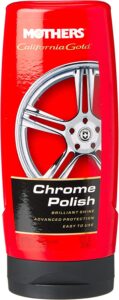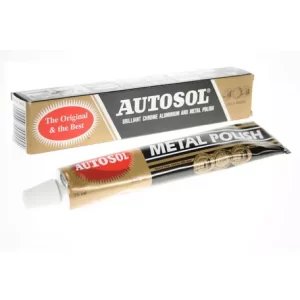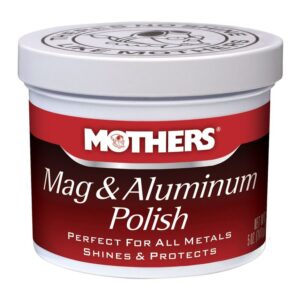
How to Clean Exhaust Tips-The Ultimate Guide
As an amature detailer with a passion for cars, I’ve come to appreciate the small details that make a vehicle look and feel its best. One aspect that many car enthusiasts tend to overlook is the cleanliness of their exhaust tips. In this guide, we’ll delve into everything you need to know about keeping your exhaust tips looking shiny and new.
Sparkling exhaust tips don’t just enhance your car’s appearance; they also help prevent corrosion and damage. When left uncared for, exhaust tips can accumulate grime, soot, and harmful substances that eventually lead to rust and deterioration. Maintaining your exhaust tips not only keeps them gleaming but also helps avoid unnecessary expenses on repairs in the future.

Throughout this blog post, we’ll explore the process of identifying different types of exhaust tips, gathering the right supplies for the job, and preparing your exhaust tips for a thorough cleaning. We’ll then guide you through the cleaning process step-by-step, along with sharing valuable tips on how to maintain your exhaust tips in the long run.By the end of this article, you’ll have all the know-how and expertise needed to keep your exhaust tips looking pristine and well-maintained.
Lets take a look!
How Do Exhaust Tips Get Dirty?
Understanding how exhaust tips get dirty is essential in learning how to maintain them properly. There are several factors that contribute to the accumulation of dirt, grime, and soot on your exhaust tips. Some of these factors merely cause cosmetic issues, while others can have more serious consequences. In this section, we’ll discuss the various ways exhaust tips get dirty and identify situations that warrant more than just routine cleaning.
- Combustion by-products: As a natural by-product of the combustion process in your car’s engine, exhaust gases contain carbon deposits and other contaminants. When these gases are expelled through the exhaust system, they leave behind a layer of soot and grime on the inner and outer surfaces of your exhaust tips.
- Road grime: Dirt, mud, and debris from the road can accumulate on your vehicle’s underside, including your exhaust tips. This buildup, combined with moisture and other environmental factors, can cause your exhaust tips to appear dull and dirty.
- Corrosion: Exhaust tips made of metal, especially chrome or stainless steel, are susceptible to oxidation and rust when exposed to moisture, salt, and other corrosive substances. Over time, this corrosion can cause your exhaust tips to look unsightly and may even result in structural damage if left unchecked.
- Chemical reactions: Exposure to acidic or alkaline substances, such as bird droppings or harsh cleaning agents, can cause discoloration or staining on your exhaust tips. These unsightly marks can be challenging to remove without the right cleaning techniques and products.
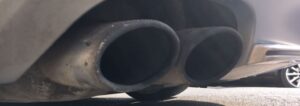
While a layer of soot and road grime is mainly a cosmetic issue that can be addressed through regular cleaning, corrosion and chemical reactions require more attention. If you notice rust or signs of damage on your exhaust tips, it’s crucial to address the issue promptly. In such cases, a thorough cleaning may not suffice, and you may need to consider professional intervention or even replacing the affected exhaust tips
Identifying the Type of Exhaust Tips You Are Working On
Before starting the cleaning process, it’s crucial to identify the material of your exhaust tips, as each type requires specific cleaning techniques and products. In this section, we’ll discuss the most common types of exhaust tips, the nuances involved in cleaning each one, and how to identify them.
- Chrome: Chrome exhaust tips are popular for their shiny and reflective appearance. They are usually very smooth and mirror-like. The easiest way to identify chrome exhaust tips is by their high-gloss, silver finish that offers a clear reflection of its surroundings. When cleaning chrome exhaust tips, use a chrome-specific cleaner or polish and a soft microfiber towel to avoid scratching the surface. Be gentle when removing dirt and grime, as excessive scrubbing can damage the chrome finish.
- Stainless steel: Stainless steel exhaust tips are known for their durability and resistance to rust. They have a more matte or brushed appearance compared to chrome exhaust tips. Stainless steel exhaust tips can be identified by their somewhat duller silver color and a less reflective finish. To clean stainless steel exhaust tips, use a stainless steel cleaner or a mild metal polish with a microfiber cloth or a non-abrasive sponge. Pay extra attention to areas with visible stains or corrosion to ensure the exhaust tips regain their shine.
- Aluminum: Aluminum exhaust tips are lightweight and less prone to rust but can oxidize and develop a dull, chalky appearance over time. Aluminum exhaust tips can be identified by their lighter weight and slightly darker silver or gray color. To clean aluminum exhaust tips, use a specialized aluminum cleaner or a gentle metal polish. Apply the cleaner with a soft cloth or sponge, and avoid using harsh abrasives that can scratch the surface.
- Titanium: Titanium exhaust tips are prized for their lightweight nature and corrosion resistance, often found on high-performance vehicles. Titanium is sensitive to scratches and can develop a distinct coloration due to heat exposure. To identify titanium exhaust tips, look for their darker, almost gunmetal-like color, and a distinct heat-induced color gradient ranging from blue to purple hues. To clean titanium exhaust tips, use a cleaner designed for titanium or a mild metal polish. Utilize a soft microfiber cloth and gentle pressure to prevent surface damage.

By accurately identifying the type of exhaust tips on your vehicle, you can ensure you’re using the appropriate cleaning products and techniques to achieve the best results while preventing any potential damage.
What Do You Need To Clean Exhaust Tips?
Having the right supplies at hand is essential for effectively cleaning your exhaust tips while preventing any potential damage. In this section, we’ll discuss the necessary supplies for cleaning each type of exhaust tip material and provide recommendations for the best products to use.
Chrome Exhaust Tips
- Exhaust tip cleaner or metal polish: Choose a chrome-specific cleaner or polish, like Mothers Chrome Polish or Meguiar’s All Metal Polish.
- Microfiber towels: Soft, lint-free microfiber towels for applying the cleaner, removing it, and polishing the chrome exhaust tips.
- Soft-bristle brush: A toothbrush or nylon-bristle detailing brush for reaching tight areas and crevices.
- Protective gloves, mask, and eye protection: Wear gloves to protect your hands, and consider wearing a mask or eye protection to prevent irritation from strong fumes.
Stainless Steel Exhaust Tips
- Exhaust tip cleaner or metal polish: Opt for a stainless steel cleaner, like Bar Keepers Friend, or a mild metal polish, like Autosol Metal Polish.
- Microfiber towels: Soft, lint-free microfiber towels for applying the cleaner, removing it, and polishing the stainless steel exhaust tips.
- Soft-bristle brush: A toothbrush or nylon-bristle detailing brush for reaching tight areas and crevices.
- Protective gloves, mask, and eye protection: Wear gloves to protect your hands, and consider wearing a mask or eye protection to prevent irritation from strong fumes.
Aluminum Exhaust Tips
- Exhaust tip cleaner or metal polish: Choose a specialized aluminum cleaner, like Mothers Mag & Aluminum Polish, or a gentle metal polish.
- Microfiber towels: Soft, lint-free microfiber towels for applying the cleaner, removing it, and polishing the aluminum exhaust tips.
- Soft-bristle brush: A toothbrush or nylon-bristle detailing brush for reaching tight areas and crevices.
- Protective gloves, mask, and eye protection: Wear gloves to protect your hands, and consider wearing a mask or eye protection to prevent irritation from strong fumes.
Titanium Exhaust Tips
- Exhaust tip cleaner or metal polish: Use a cleaner designed for titanium or mild metal polish.
- Microfiber towels: Soft, lint-free microfiber towels for applying the cleaner, removing it, and polishing the titanium exhaust tips.
- Soft-bristle brush: A toothbrush or nylon-bristle detailing brush for reaching tight areas and crevices.
- Protective gloves, mask, and eye protection: Wear gloves to protect your hands, and consider wearing a mask or eye protection to prevent irritation from strong fumes.
By gathering the appropriate supplies for your exhaust tip material type, you’ll be well-prepared to clean and maintain your exhaust tips safely and effectively. Remember to always follow the manufacturer’s instructions on the cleaning products you use and test a small, inconspicuous area of your exhaust tips before proceeding with the cleaning process.
Preparing the Exhaust Tips for Cleaning
Thorough preparation is key to a safe and effective cleaning process for your exhaust tips. In this section, we’ll delve deeper into the necessary steps for preparing your exhaust tips for cleaning, including allowing the vehicle to cool down, removing loose debris, and assessing the level of dirt and grime.
1)Allowing the vehicle to cool down
Since exhaust tips can become extremely hot after driving, it’s crucial to let your vehicle cool down before attempting to clean them. Waiting for the exhaust tips to cool down will prevent potential burns or damage to the material. Ideally, wait at least an hour after driving or until the exhaust tips are cool to the touch. While waiting, take this time to gather your cleaning supplies and review the instructions for the products you plan to use.
2)Removing loose debris
Removing loose debris is an essential first step in the cleaning process. It helps prevent scratches caused by dirt and grit while cleaning. Here are some tips to ensure proper removal of debris:
- If possible, wash your car before cleaning the exhaust tips. This way, you’ll remove any loose dirt or debris from the surrounding areas that could potentially scratch the surface during cleaning.
- Use a gentle car wash soap and a soft sponge or wash mitt to clean the surrounding areas of the exhaust tips.
- For a more targeted approach, use a soft-bristle brush or a microfiber towel to gently remove any loose dirt from the exhaust tips themselves.
- Be mindful of any sharp edges or protrusions that could cause injury while removing debris.

3)Assessing the level of dirt and grime:
Before deciding on the appropriate cleaning method and products, it’s essential to carefully inspect your exhaust tips to determine the extent of dirt, soot, and grime buildup. Here are some factors to consider during the assessment:
- Examine the exhaust tips for light layers of soot and dirt versus heavy staining or built-up grime.
- Check for signs of rust, pitting, or discoloration, which could indicate a need for more aggressive cleaning products and techniques.
- Consider the material of your exhaust tips, as some materials may require specialized cleaning products or methods.
- Be prepared to adjust your cleaning approach based on the condition of your exhaust tips. If your initial cleaning efforts don’t yield the desired results, consider trying a different product or technique.
By properly preparing your exhaust tips for cleaning, you can ensure a safe and effective process that will yield the best results while minimizing the risk of damage to your vehicle. With your exhaust tips cooled down, debris removed, and the level of dirt and grime assessed, you’re now ready to move on to the cleaning process!
Step-by-Step Guide to Cleaning Exhaust Tips
In this section, we’ll provide a comprehensive, step-by-step guide to cleaning your exhaust tips safely and effectively. We’ll cover every aspect of the process, from applying the cleaner to rinsing and wiping. Throughout this guide, we’ll emphasize safety and the importance of avoiding scratches or damage to the exhaust surface.
Applying the cleaner or polish:
Choose the appropriate cleaner or polish based on your exhaust tips’ material and the level of dirt and grime. Make sure to shake the product well before use to ensure an even consistency.
-
- Preparing the microfiber towel: Fold the microfiber towel into quarters, so you have eight clean sides to work with. Apply the cleaner or polish to one section of the towel, ensuring it’s saturated but not dripping. This method allows you to control the amount of product applied to the exhaust tips and reduces waste.
- Applying the product: Gently apply the cleaner or polish to the exhaust tips in a circular motion, avoiding the surrounding areas. Work in small sections to prevent the cleaner or polish from drying on the surface. Start at the top of the exhaust tips and move downward, reapplying the product to the towel as needed. Follow the manufacturer’s instructions for the correct amount and application technique.

Scrubbing and cleaning:
After applying the cleaner or polish, use a soft-bristle brush or detailing brush to gently scrub the exhaust tips. Pay special attention to hard-to-reach areas, such as crevices, seams, and around the edges.
-
- Choosing the appropriate brush: Select a soft-bristle toothbrush or nylon-bristle detailing brush that is gentle enough to prevent scratches but effective in removing dirt and grime. Avoid hard-bristle brushes or steel wool, as these can damage the exhaust tip’s surface.
- Scrubbing technique: Use gentle pressure when scrubbing, applying more force only if necessary for stubborn stains or grime. Be cautious not to use excessive force or abrasive materials that could scratch the surface of the exhaust tips. When working in tight spaces, consider using cotton swabs or a small brush to effectively remove dirt and grime.
- Removing stubborn stains and grime: For particularly stubborn stains or grime, use a toothpick or plastic scraper to carefully remove the buildup. Be gentle and cautious to avoid scratching the surface. In some cases, it may be necessary to apply additional cleaner or polish and repeat the scrubbing process for improved results.
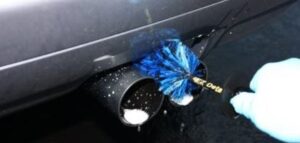
Rinsing and wiping:
After scrubbing the exhaust tips, it’s essential to remove the cleaner or polish residue to prevent streaks or cloudiness on the surface.
Rinsing method: Fill a bucket with clean water, and submerge a clean microfiber towel. Wring out the towel so that it’s damp but not dripping. Use the damp towel to gently wipe the surface of the exhaust tips in a circular motion, rinsing the towel frequently to ensure thorough removal of the product.
Wiping technique: Pay attention to any areas where residue may have accumulated, such as crevices, seams, and around the edges. Use the clean, damp towel to work the residue out of these tight spaces. If necessary, use a cotton swab or small brush to remove residue from intricate areas.
Final touches: Once you’ve rinsed and wiped the exhaust tips, use a dry microfiber towel to buff the surface to a shine. Fold the towel into quarters, and use one side to remove any remaining moisture from the surface. Turn the towel to a dry side, and gently buff the exhaust tips using a circular motion. If necessary, repeat the cleaning process to address any remaining stains
Maintaining Clean Exhaust Tips – How To Keep Them Clean
Regular maintenance of your exhaust tips is crucial for preserving their appearance and preventing damage. In this section, we’ll discuss how to maintain clean exhaust tips by covering cleaning frequency, preventative measures, protecting exhaust tips with sealants or coatings, and keeping a clean environment for your vehicle.
Frequency of Cleaning
The frequency of cleaning your exhaust tips will depend on your driving habits, environment, and personal preferences. As a general guideline, consider cleaning your exhaust tips every three to six months or when you notice a buildup of dirt, soot, or grime. If you live in an area with harsh weather conditions or drive on unpaved roads frequently, you may need to clean your exhaust tips more often.
Preventative Measures
Taking proactive steps to prevent dirt and grime buildup can extend the time between cleanings and help maintain your exhaust tips’ appearance. Some preventative measures include:
- Regularly washing your vehicle, including the area around the exhaust tips.
- Avoiding driving through puddles or on unpaved roads whenever possible.
- Promptly addressing any fluid leaks or engine issues that could contribute to excessive soot and grime on the exhaust tips.
Protecting Exhaust Tips with Sealants/Coatings
Applying a protective sealant or coating to your exhaust tips can help repel dirt, grime, and soot, making them easier to clean and maintain. Sealants or coatings specifically designed for exhaust tips or metal surfaces are ideal. Follow the manufacturer’s instructions for application and reapplication intervals. Remember that these products aren’t a substitute for regular cleaning, but they can make the process more manageable and extend the life of your exhaust tips.

Keeping a Clean Environment for Your Vehicle
The environment in which you store your vehicle plays a significant role in maintaining clean exhaust tips. Some ways to ensure a clean environment for your car include:
- Parking your vehicle in a garage or covered area whenever possible to protect it from dust, dirt, and weather elements.
- Regularly sweeping or cleaning the area where you park your car to minimize the accumulation of dirt and debris.
- Using a car cover when parking outdoors for extended periods to shield your vehicle from dust, dirt, and other environmental factors that can contribute to dirty exhaust tips.
Frequently Asked Questions.
Q: Can I use any cleaning product on my exhaust tips(household items)?
-
- A: It’s crucial to use a cleaner or polish that’s appropriate for the material of your exhaust tips. Using the wrong product could lead to damage or discoloration. Always check the manufacturer’s instructions to ensure the product is suitable for your exhaust tips.
Q: Can I prevent my exhaust tips from getting dirty?
-
- A: While it’s challenging to completely prevent exhaust tips from getting dirty due to their exposure to road dirt, soot, and exhaust gases, certain preventative measures can reduce the buildup. Regularly washing your car, avoiding driving on unpaved roads, and applying a protective sealant or coating can help maintain cleaner exhaust tips for longer.
Q: Can I use a sealant or coating on any exhaust tips?
-
- A: Most sealants and coatings are designed to work on a variety of materials, but it’s always a good idea to check the product specifications and manufacturer’s instructions to ensure it’s safe for your exhaust tips.
Q: What happens if I don’t clean my exhaust tips regularly?
-
- A: Over time, the buildup of dirt, soot, and grime can lead to corrosion or damage. Regular cleaning helps maintain the appearance of your exhaust tips and can prevent potential issues.
In Summary
Cleaning and maintaining your exhaust tips is an essential aspect of vehicle care that contributes to your car’s overall aesthetics and prevents corrosion or damage. By following the step-by-step guide and maintenance tips provided in this article, you can keep your exhaust tips looking pristine and protect them from harm.
We hope you found this guide on how to clean exhaust tips helpful and informative. If you have any tips, tricks, or techniques that you’ve found effective in cleaning and maintaining your exhaust tips, please share them in the comments section below. We’d love to hear your insights, and your suggestions might help others achieve outstanding results too.
Happy Detailing!
Go Home
